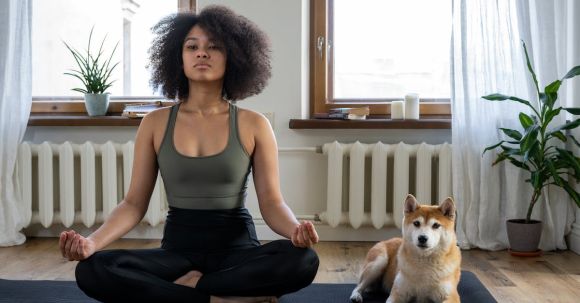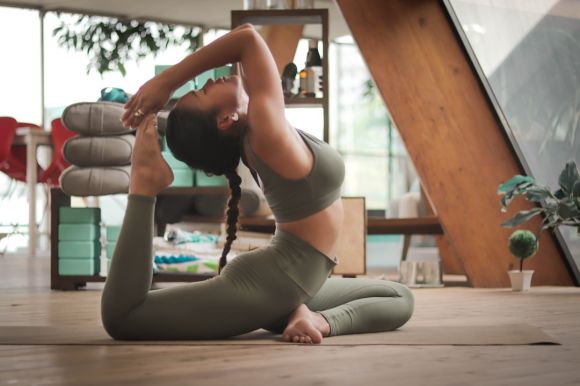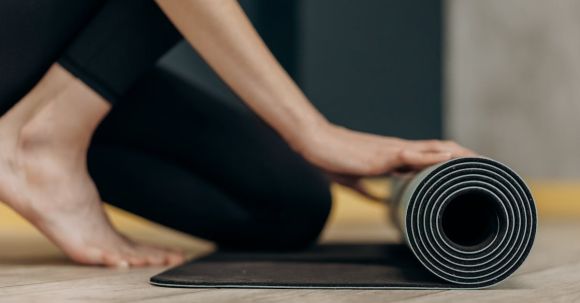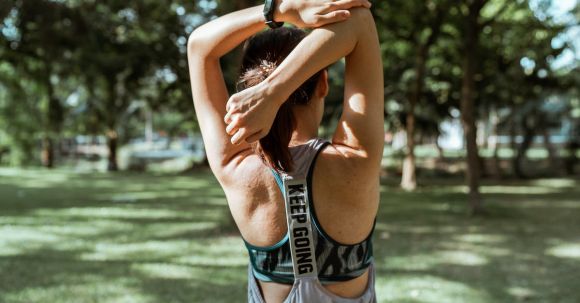In today's fast-paced world, finding time for exercise can be a challenge. With work, family, and other commitments, it's easy to put fitness on the back burner. However, with the rise of online coaching, fitting exercise into your busy lifestyle has never been easier. In this article, we will explore how online coaching can help you prioritize your health and incorporate exercise into your daily routine.
Author: fit-on
Having good balance and stability is crucial for everyday activities such as walking, running, and even standing still. It helps prevent falls, improves athletic performance, and contributes to overall physical well-being. If you find yourself struggling with balance and stability, don't worry – there are several exercises and strategies you can incorporate into your routine to improve these essential skills. In this article, we will explore some effective techniques to enhance your balance and stability.
Strengthen Your Core Muscles
One of the key factors in maintaining balance and stability is having a strong core. Your core muscles, including the abdominals, lower back, and hips, provide a solid foundation for the rest of your body. By strengthening these muscles, you can improve your overall stability. To work on your core strength, try incorporating exercises such as planks, Russian twists, and bicycle crunches into your routine. These exercises engage multiple muscle groups and help develop a stable core, which is essential for maintaining balance.Practice Yoga and Pilates
Yoga and Pilates are both excellent practices for improving balance and stability. These disciplines focus on alignment, flexibility, and core strength, making them ideal for enhancing your overall stability. In yoga, poses such as tree pose and warrior III challenge your balance and help improve your body's proprioception, or awareness of its position in space. Pilates exercises, on the other hand, often involve equipment such as stability balls or resistance bands, which help strengthen the muscles responsible for balance and stability.Incorporate Balance Exercises
Specific balance exercises can target the muscles and neural pathways responsible for maintaining stability. One simple exercise you can try is standing on one leg. Start by standing near a wall or a sturdy object for support, then lift one leg off the ground and hold the position for as long as you can. As you progress, challenge yourself by closing your eyes or performing the exercise on an unstable surface, such as a foam pad. Another effective balance exercise is the heel-to-toe walk. Imagine you are walking on a tightrope, placing one foot directly in front of the other with each step. This exercise helps improve your balance by challenging your coordination and strengthening the muscles in your feet and ankles.Engage in Tai Chi
Tai Chi is a Chinese martial art that combines slow, flowing movements with deep breathing and relaxation techniques. It is known for its benefits in improving balance and stability, especially in older adults. The slow, deliberate movements of Tai Chi require constant weight shifting, challenging your balance and coordination. Regular practice can help strengthen your leg muscles, improve your posture, and enhance your overall stability.Maintain a Healthy Lifestyle
In addition to specific exercises, maintaining a healthy lifestyle can contribute to better balance and stability. Eating a balanced diet and staying hydrated can help keep your muscles and joints in optimal condition. Additionally, getting enough sleep and managing stress levels can improve your overall physical and mental well-being, which can positively impact your balance.Conclusion: A Steady Foundation for Everyday Life
Improving your balance and stability requires consistent effort and dedication. By integrating core strengthening exercises, incorporating yoga or Pilates into your routine, engaging in balance exercises, practicing Tai Chi, and maintaining a healthy lifestyle, you can enhance your overall stability and enjoy the benefits of a steady foundation for everyday life. So start incorporating these techniques into your routine today and watch as your balance and stability improve over time.
In today's fast-paced world, finding time to hit the gym can be a challenge. But don't worry, you can still get fit and stay in shape right from the comfort of your own home! Home workouts are a convenient and effective way to get your heart pumping and your muscles working. Whether you have a fully equipped home gym or just a small corner in your living room, there are plenty of exercises you can do to get the results you desire. Here are some tips and ideas to help you get started on your home fitness journey.
1. Create a Dedicated Workout Space
The first step to successful home workouts is to create a dedicated workout space. This can be a spare room, a corner in your living room, or even your backyard. Clear out any clutter and make sure you have enough space to move around comfortably. Having a designated area for your workouts will help you stay focused and motivated.2. Set Clear Goals
Before you start your home workouts, it's important to set clear goals. Do you want to lose weight, build muscle, or improve your overall fitness? Having specific goals will help you tailor your workouts and track your progress. Write down your goals and refer to them regularly to stay motivated and on track.3. Use Bodyweight Exercises
You don't need fancy equipment to get a great workout at home. Bodyweight exercises are a fantastic way to build strength and endurance. Push-ups, squats, lunges, planks, and burpees are just a few examples of bodyweight exercises that target multiple muscle groups. Mix and match these exercises to create a challenging and effective workout routine.4. Incorporate Cardiovascular Exercises
Cardiovascular exercises are essential for improving your heart health and burning calories. Jumping jacks, high knees, jump rope, and mountain climbers are all great options for getting your heart rate up. You can also try dance-based workouts or follow along with online cardio classes. Aim for at least 30 minutes of cardiovascular exercise three to five times a week.5. Get Creative with Household Items
Don't have dumbbells or resistance bands? No problem! Look around your house for everyday items that can double as exercise equipment. Water bottles, canned goods, and backpacks filled with books can all be used for resistance training. Get creative and think outside the box – you'll be surprised at how many household items can be repurposed for your workouts.6. Stay Consistent and Motivated
Consistency is key when it comes to home workouts. Set a schedule and stick to it. Treat your workouts as appointments that you can't miss. Find ways to stay motivated, whether it's by tracking your progress, rewarding yourself for reaching milestones, or working out with a friend virtually. Remember, every workout counts, no matter how short or intense it may be.7. Stay Safe and Listen to Your Body
While home workouts are a convenient option, it's important to prioritize safety. Warm up before each workout to prevent injuries, and cool down afterward to promote recovery. If you're new to exercising or have any underlying health conditions, consult with a healthcare professional before starting a new fitness routine. Listen to your body and make modifications as needed. In conclusion, home workouts are a fantastic way to stay active and fit without leaving your house. With a little creativity and dedication, you can achieve your fitness goals right from the comfort of your own home. So, clear out some space, set your goals, and get ready to sweat it out. Remember, consistency and motivation are key – you've got this!
Are you looking to transform your body and achieve a toned, flexible physique? Look no further than power yoga. This dynamic and challenging form of yoga has gained popularity in recent years for its ability to not only improve physical fitness but also promote mental well-being. In this article, we will explore the benefits of power yoga and how it can help you achieve your fitness goals.
Building Strength and Stamina
One of the key aspects of power yoga is its emphasis on building strength and stamina. Unlike traditional yoga practices that focus on slower movements and static poses, power yoga incorporates dynamic movements that target multiple muscle groups simultaneously. This helps to increase overall strength and endurance, making it an excellent workout for those looking to tone their bodies.Improving Flexibility and Balance
In addition to building strength, power yoga also helps to improve flexibility and balance. The flowing sequences and challenging poses require a great deal of flexibility, helping to stretch and lengthen your muscles. Regular practice of power yoga can gradually increase your range of motion and improve your overall flexibility. Additionally, the focus on balance in power yoga helps to enhance stability and coordination, leading to better posture and body control.Enhancing Cardiovascular Health
Power yoga is not only beneficial for building strength and flexibility but also for improving cardiovascular health. The fast-paced, continuous movements of power yoga raise your heart rate and increase blood circulation, providing a cardiovascular workout similar to a traditional aerobic exercise. This helps to strengthen your heart, improve lung capacity, and boost overall cardiovascular fitness.Burning Calories and Losing Weight
If you're looking to shed some pounds and burn calories, power yoga can be a valuable addition to your fitness routine. With its combination of strength, flexibility, and cardiovascular components, power yoga is an effective calorie-burning workout. A one-hour session of power yoga can burn anywhere from 300-600 calories, depending on your intensity level. Regular practice of power yoga, coupled with a balanced diet, can contribute to healthy and sustainable weight loss.Reducing Stress and Promoting Mental Well-being
In addition to its physical benefits, power yoga is known for its ability to reduce stress and promote mental well-being. The focus on deep breathing and mindfulness during power yoga helps to calm the mind and release tension. The physical exertion of power yoga also stimulates the release of endorphins, the body's natural feel-good hormones, which can improve mood and reduce feelings of anxiety and depression.Creating a Mind-Body Connection
Power yoga is not just a physical workout; it is also a practice that cultivates a strong mind-body connection. As you flow through the sequences and hold challenging poses, you become more aware of your body and its capabilities. This increased self-awareness can extend beyond the yoga mat, leading to improved body awareness and mindfulness in your everyday life. In conclusion, power yoga is a transformative practice that can help you achieve a toned, flexible body while promoting mental well-being. By incorporating dynamic movements, challenging poses, and deep breathing, power yoga builds strength, improves flexibility, enhances cardiovascular health, burns calories, reduces stress, and creates a powerful mind-body connection. Whether you're a beginner or an experienced yogi, power yoga can be adapted to suit your fitness level and goals. So why wait? Step onto your mat and start transforming your body with power yoga today.
Speed and quickness are essential attributes in many sports. Whether you're a soccer player trying to outrun defenders, a basketball player looking to blow past your opponent, or a tennis player aiming to react swiftly to every shot, improving your speed and quickness can significantly elevate your performance. By incorporating sports-specific training into your workout routine, you can maximize your potential and take your game to the next level.
The Importance of Sports-specific Training
Sports-specific training refers to exercises and drills that mimic the movements and demands of a particular sport. It focuses on developing the specific muscles, skills, and energy systems required for optimal performance. Unlike general fitness training, which improves overall strength and endurance, sports-specific training hones in on the specific requirements of your chosen sport.Benefits of Sports-specific Training for Speed and Quickness
Sports-specific training offers several benefits for enhancing speed and quickness: 1. Improved Muscle Coordination: By engaging in movements that replicate those used in your sport, you can enhance the coordination between your muscles. This improved coordination allows for more efficient movements, resulting in increased speed and quickness. 2. Enhanced Reaction Time: Sports-specific training often includes drills that require quick reaction times. By practicing these drills regularly, you can improve your ability to react swiftly to changing situations, giving you a competitive edge on the field or court. 3. Increased Power and Explosiveness: Many sports-specific exercises focus on developing explosive power, which is crucial for quick bursts of speed and rapid changes in direction. By incorporating exercises that target power and explosiveness, you can enhance your speed and quickness on the field.Sports-specific Training Techniques
Here are some effective sports-specific training techniques to enhance your speed and quickness: 1. Interval Training: Interval training involves alternating between high-intensity exercises and periods of rest or lower intensity. This type of training is excellent for improving speed and quickness, as it simulates the stop-and-start nature of many sports. Incorporate short sprints, agility ladder drills, and shuttle runs into your interval training sessions. 2. Plyometrics: Plyometric exercises focus on explosive movements that enhance power and speed. Box jumps, medicine ball throws, and lateral bounds are just a few examples of plyometric exercises that can significantly improve your speed and quickness. 3. Sport-specific Drills: Practice drills that closely mimic the movements and demands of your sport. For example, basketball players can work on dribbling and shooting drills that require quick changes in direction and reaction times. Soccer players can benefit from ladder drills that improve footwork and agility. 4. Strength Training: While speed and quickness are primarily dependent on technique and coordination, strength training plays a vital role in supporting these attributes. Focus on exercises that target the muscles used during your sport, such as squats, lunges, and deadlifts. Remember to maintain proper form and gradually increase the weight to avoid injury. Incorporating sports-specific training into your workout routine is essential for enhancing your speed and quickness. By focusing on the specific demands of your sport and incorporating targeted exercises and drills, you can maximize your athletic potential. Remember to consult with a fitness professional or coach to ensure you are using proper techniques and to tailor your training program to your specific needs. With dedication and consistency, you'll be well on your way to becoming a faster and quicker athlete.
In today's busy world, finding time to go to the gym can be a challenge. However, that doesn't mean you have to neglect your fitness goals, especially when it comes to strengthening your lower body. With the right home workouts, you can effectively target your legs, glutes, and core muscles – all from the comfort of your own home. So, let's dive into some effective exercises that will help you build strength and tone your lower body.
Squat Your Way to Stronger Legs
Squats are one of the best exercises for strengthening your lower body. They engage multiple muscle groups, including your quadriceps, hamstrings, and glutes. To perform a squat, stand with your feet shoulder-width apart, then lower your hips back and down as if you're sitting into a chair. Make sure to keep your chest up and your knees in line with your toes. Aim for 3 sets of 10-12 reps, gradually increasing the weight as you get stronger.Lunge for Toned Glutes
Lunges are another fantastic exercise for targeting your lower body. They primarily work your glutes, hamstrings, and quadriceps. To do a lunge, take a step forward with your right foot, then lower your body down until your right knee is at a 90-degree angle. Your left knee should be close to the ground but not touching it. Push through your right heel to return to the starting position, then repeat on the other side. Aim for 3 sets of 10-12 reps on each leg.Fire Up Your Core with Planks
While planks are often associated with core strength, they also engage your lower body muscles. To perform a plank, start in a push-up position, then lower your forearms to the ground. Engage your core and hold this position for as long as you can, aiming for at least 30 seconds to start. As you get stronger, you can gradually increase the duration. Planks not only strengthen your abs but also work your glutes, hamstrings, and quadriceps.Jump Your Way to Explosive Power
Adding plyometric exercises to your home workouts can take your lower body strength to the next level. One effective plyometric exercise is the squat jump. Start in a squat position, then explosively jump up, reaching as high as you can. Land softly back into the squat position, then immediately jump again. Aim for 3 sets of 8-10 reps, focusing on explosive power and control.Diversify with Hip Thrusts
Hip thrusts are an excellent exercise for targeting your glutes and hamstrings. To perform a hip thrust, start by sitting on the ground with your knees bent and feet flat on the floor. Place a weight or a resistance band around your hips, then push your hips up towards the ceiling, squeezing your glutes at the top. Lower back down and repeat for 3 sets of 10-12 reps. As you get stronger, you can increase the weight or resistance.Conclusion: Strengthen and Tone Your Lower Body at Home
Don't let a lack of time or access to a gym hinder your lower body strength goals. With these home workouts, you can effectively target your legs, glutes, and core muscles. Remember to focus on proper form and gradually increase the intensity as you get stronger. By incorporating these exercises into your routine, you'll be well on your way to a stronger and more toned lower body.
Emotional blockages can have a significant impact on our overall well-being and quality of life. These blockages can manifest as unresolved traumas, negative thought patterns, or suppressed emotions. They can prevent us from experiencing true emotional healing and hinder our personal growth. However, through the practice of meditation, we can begin to release these blockages and find a path towards emotional healing.
Understanding Emotional Blockages
Emotional blockages are barriers that prevent us from fully expressing and processing our emotions. These blockages can be caused by past traumatic experiences, societal conditioning, or even self-imposed limitations. When these blockages are present, it can result in a range of emotional issues, such as anxiety, depression, or anger.Meditation as a Tool for Release
Meditation is a powerful tool that can help us release emotional blockages and find emotional healing. By creating a space of stillness and inner awareness, meditation allows us to observe and acknowledge our emotions without judgment or resistance. Through regular practice, we can begin to unravel the layers of emotional blockages and release them from our being.Cultivating Mindfulness
Mindfulness is a key component of meditation that allows us to become aware of our thoughts, emotions, and sensations in the present moment. By cultivating mindfulness, we can develop a deeper understanding of our emotional blockages and their underlying causes. This awareness enables us to address these blockages directly and begin the process of healing.Breathing into Emotions
One technique often used in meditation is to focus on the breath. By bringing our attention to the breath and consciously breathing into our emotions, we can create space for these emotions to arise and be released. As we breathe into our emotions, we allow ourselves to fully experience them without judgment or resistance. This process can be incredibly healing and transformative.Letting Go of Attachments
Emotional blockages often stem from attachments and clinging to certain emotions or experiences. Through meditation, we can learn to let go of these attachments and cultivate a sense of detachment. By observing our emotions without clinging or aversion, we can begin to release the blockages that are holding us back.Connecting with Self-Compassion
Self-compassion is a vital aspect of emotional healing. Through meditation, we can develop a greater sense of self-compassion by cultivating kindness and understanding towards ourselves. By acknowledging our pain and suffering without judgment, we create a safe space for emotional healing to occur.Finding Support and Guidance
While meditation can be a powerful tool for emotional healing, it is essential to seek support and guidance when needed. Engaging in therapy or seeking the assistance of a meditation teacher can provide additional insights and techniques to aid in the release of emotional blockages.Embracing the Journey of Emotional Healing
Emotional healing is not a linear process but rather a journey of self-discovery and growth. Through the practice of meditation, we can begin to release emotional blockages and find a path towards healing. By cultivating mindfulness, breathing into emotions, letting go of attachments, and connecting with self-compassion, we create space for emotional healing to occur.Conclusion: Embracing Emotional Healing through Meditation
Emotional blockages can be deeply ingrained within us, but through the practice of meditation, we can begin to release these blockages and find emotional healing. By cultivating mindfulness, breathing into our emotions, letting go of attachments, and connecting with self-compassion, we create a safe space for emotional healing to occur. Remember, emotional healing is a journey, and it requires patience, self-compassion, and support. Through meditation, we can embark on this journey and find the peace and healing we seek.
In today's fast-paced world, finding inner stillness and calmness can be a challenge. With endless distractions and constant stimulation, our minds often become overwhelmed and restless. However, through the practice of yoga, we can learn to calm our minds and find that much-needed inner stillness. In this article, we will explore how yoga can help us achieve a sense of calmness and tranquility.
Understanding the Mind-Body Connection
Before diving into the world of yoga, it's important to understand the mind-body connection. Our minds and bodies are intricately linked, and what affects one will undoubtedly affect the other. When our minds are cluttered and restless, our bodies can become tense and agitated. On the other hand, when we find peace and stillness in our minds, our bodies can relax and find balance.The Power of Breath
One of the fundamental aspects of yoga is breath control. The breath is a powerful tool that can help us calm our minds and find inner stillness. Through deep, conscious breathing, we can activate the body's relaxation response, reducing stress and anxiety. Practicing deep breathing techniques during yoga helps to anchor our attention to the present moment, allowing the mind to quieten and find peace.Finding Focus through Asanas
Asanas, or yoga postures, are another key element in calming the mind. By practicing various yoga poses, we can bring our attention to the physical sensations in our bodies, helping to shift our focus away from the constant stream of thoughts. Asanas provide an opportunity to cultivate mindfulness, as we become fully present in the movement and alignment of our bodies. Through this focused attention, the mind can settle into a state of stillness.Meditation and Mindfulness
Yoga and meditation go hand in hand when it comes to calming the mind. Meditation is the practice of training the mind to focus and redirect our thoughts. By incorporating meditation into our yoga practice, we can deepen our ability to find inner stillness. Mindfulness meditation, in particular, encourages us to observe our thoughts and emotions without judgment, allowing them to come and go without attachment. This practice can help us develop a sense of inner calmness and detachment from the constant mental chatter.Creating a Sacred Space
To fully embrace the calming effects of yoga, it's essential to create a sacred space for practice. Find a quiet corner in your home or outdoors where you can dedicate time to your yoga practice. Declutter the space, light candles or incense, and play soft, soothing music if desired. By creating a serene environment, you are setting the stage for a calm and peaceful mind.Embracing a Regular Yoga Practice
Consistency is key when it comes to reaping the benefits of yoga. To truly calm your mind and find inner stillness, it's important to make yoga a regular part of your routine. Set aside dedicated time each day, even if it's just a few minutes, to practice yoga. Over time, you will notice the cumulative effects of your practice, as your mind becomes more at ease and your ability to find inner stillness deepens.Conclusion: Discovering the Power of Yoga
In a world that often feels chaotic and overwhelming, finding inner stillness and calmness is a precious gift. Through the practice of yoga, we can cultivate a peaceful mind and find a sense of tranquility amidst the noise. By embracing the mind-body connection, harnessing the power of breath, practicing asanas, and incorporating meditation and mindfulness, we can calm our minds and discover the transformative power of yoga. So, take a deep breath, roll out your yoga mat, and embark on a journey towards inner stillness and peace.
Having a strong and healthy back is essential for overall well-being. It not only helps in maintaining good posture but also supports the spine and prevents the risk of back pain and injuries. While many people believe that building a strong back requires expensive gym equipment or professional trainers, the truth is that you can strengthen your back right from the comfort of your own home. In this article, we will explore some effective home workouts that can help you achieve a strong and resilient back.
1. Bodyweight Exercises
One of the simplest yet most effective ways to strengthen your back at home is by performing bodyweight exercises. These exercises utilize your own body as resistance and can be done without any equipment. Push-ups, for example, are a great exercise that targets your back muscles, particularly the upper and lower back. Incorporating exercises like planks, bridges, and bird dogs into your routine can also help strengthen your back muscles.2. Yoga and Pilates
Yoga and Pilates are excellent practices for building a strong back and improving flexibility. The combination of stretching, strengthening, and breathing techniques in these disciplines helps to improve posture and alleviate back pain. Yoga poses such as the cat-cow stretch, child's pose, and downward dog are particularly beneficial for the back. Pilates exercises like the swan dive and swimming can also target and strengthen the back muscles.3. Resistance Bands
Resistance bands are affordable and versatile tools that can be used to target specific muscles in your back. These bands provide resistance throughout the range of motion, helping to build strength and endurance. Exercises such as rows, pull-aparts, and lat pulldowns can be easily performed with resistance bands to strengthen the back muscles. Additionally, resistance bands can be used to enhance other bodyweight exercises like squats and lunges, providing an extra challenge to your back muscles.4. Dumbbell Exercises
If you have access to dumbbells at home, incorporating them into your workout routine can further enhance your back strength. Exercises like bent-over rows, dumbbell pullovers, and deadlifts can be performed with dumbbells to target different areas of the back. These exercises not only strengthen the back muscles but also engage other muscles in the body, providing a full-body workout.5. Cardiovascular Exercises
While cardiovascular exercises may not directly target the back muscles, they play a crucial role in maintaining overall fitness and weight management. Engaging in activities like walking, jogging, or cycling can improve blood circulation and promote a healthy weight, reducing the strain on your back. A strong cardiovascular system can support your back muscles and enhance your overall back health. In conclusion, strengthening your back at home is not only possible but also convenient. By incorporating bodyweight exercises, yoga and Pilates, resistance bands, dumbbell exercises, and cardiovascular workouts into your routine, you can achieve a strong and resilient back. Remember to start slowly and gradually increase the intensity of your workouts to avoid injury. Consistency is key, so make sure to set aside some time each day to focus on strengthening your back. With dedication and perseverance, you can improve your back health and enjoy the benefits of a strong and pain-free back.
Fueling your body with the right foods is essential to maximize your workout performance and achieve your fitness goals. Whether you're a professional athlete or a fitness enthusiast, the right nutrition can make a significant difference in your workout results. In this article, we will explore the best foods to fuel your workouts and help you perform at your best.









